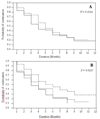High prevalence of asymptomatic plasmodium falciparum infections in a highland area of western Kenya: a cohort study
- PMID: 19476434
- PMCID: PMC2689925
- DOI: 10.1086/599317
High prevalence of asymptomatic plasmodium falciparum infections in a highland area of western Kenya: a cohort study
Abstract
Background: Transmission of malaria in an area of hypoendemicity in the highlands of western Kenya is not expected to lead to rapid acquisition of immunity to malaria. However, the subpopulation of individuals with asymptomatic Plasmodium falciparum infection may play a significant role as an infection reservoir and should be considered in malaria-control programs. Determination of the spatiotemporal dynamics of asymptomatic subpopulations provides an opportunity to estimate the epidemiological importance of this group to malaria transmission.
Methods: Monthly parasitological surveys were undertaken for a cohort of 246 schoolchildren over 12 months. The prevalence of P. falciparum infection among 2,611 blood samples was analyzed by both microscopy and polymerase chain reaction, and infection durations were determined.
Results: Infection prevalence and duration (range, 1-12 months) decreased with age and altitude. The prevalence was high among pooled blood samples recovered from children aged 5-9 years (34.4%) and from those aged 10-14 years (34.1%) but was significantly lower among blood samples obtained from older children (9.1%). The prevalence decreased from 52.4% among pooled blood samples from children living at an altitude of approximately 1,430 m to 23.3% among pooled samples from children living at an altitude of 1,580 m.
Conclusions: The prevalence of asymptomatic P. falciparum infection was high, with polymerase chain reaction analysis detecting a significantly greater number of infections, compared with microscopy. Our results are consistent with gradual acquisition of immunity with increasing age upon repeated infection, and they also show that the risk of malaria transmission is highly heterogeneous in the highland area. The results provide strong support for targeted malaria-control interventions.
Conflict of interest statement
Figures




